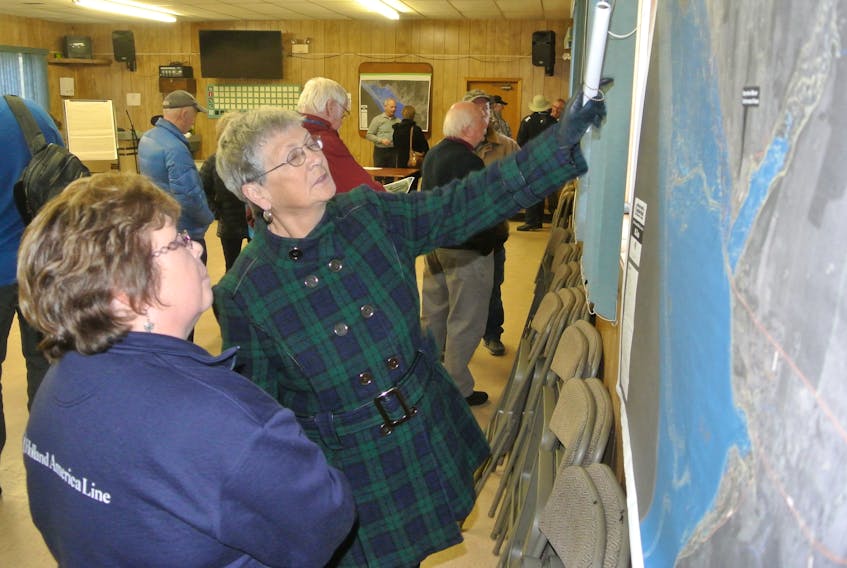ADVOCATE HARBOUR – It may be 80 years before the dike protecting Advocate Harbour could be breached by rising sea levels, but members of this community nestled between the Bay of Fundy and the towering cliffs of Cape Chignecto don’t want to wait for corrective action to be taken.
More than 50 residents packed into the community’s fire hall Sunday to hear the details of a study taking place that will look at options available, including making the dike higher or moving key pieces of infrastructure to higher ground.
“Knowing what the impact of global warming and rising sea levels could be it’s imperative that we do something and I feel the best option is to fix the dike,” Kirk Reid said following the meeting. “We have to keep our community intact as much as possible and protect our way of life so people can continue to live in Advocate and know that it’s going to be a safe place.”
Reid, the former principal at Advocate District School, said people are concerned about storm surges and rising tides, but there’s not an overwhelming feeling of fear or dread.
Cumberland County’s EMO coordinator Mike Johnson told the meeting that rising sea levels, brought on by global warming, are a fact the community is going to have to face eventually. He said the best data to date indicates the dike could be overwhelmed by 2100. However, he warned, there’s a chance a storm surge could overcome the protective structure sooner than that.
Johnson said the county wants to know the options before committing money or other resources to a solution.
“We’re looking for an arrow that’s going to guide us in a direction that will tell us yes, this is something we want to do or no, this is something we don’t want to do,” Johnson said. “It’s like looking into a crystal ball. The experts are telling us this is coming and this is what we’re doing to try to prepare for when it does happen.”
CBCL has been hired to conduct the study and has already begun its work. He’s hoping the study will be complete by the end of March or early April and he said there will be additional public meetings to gather public input on the options available.
Kevin Bekkers manages dikes for the provincial Agriculture Department. He said the situation faced by Advocate Harbour is similar to other communities along the Bay of Fundy. The province, he said, manages more than 80 dike structures along the bay and, in some cases, the decision will have to be made on which ones to protect and which ones to abandon.
“With sea level rise by 2100 you’re going to arrive at a situation where you’re either going to have to top the dikes or move the buildings,” Bekkers said. “You can drive through Advocate and on the right side of the road there are a lot of homes and buildings that are going to be under water if that dike and seawall were to fail. I don’t think there’s anyone here that doesn’t know that from living in this community.”
Bekkers said the study is preliminary and something that’s going to have to be replicated along the Bay of Fundy. He said Advocate Harbour is ahead of the game in doing its study now, something that will prove invaluable when it’s time to go to government seeking infrastructure money to shore up the dike.
At present, he said, the dike is in good condition. However, he added, the dike was built for agricultural purposes.
“It’s not built to protect the highway, homes or prevent loss of life,” Bekkers said. “If the dike is the solution for the future, it would have to look different than it does today. We’re not going to build an agricultural dike because it was originally build to protect some farmland, not the community of Advocate.”
Resident David Bentley agrees something needs to be done, but he said he doesn’t agree with sounding the alarm about the future because it could impact development or property values in the community.
“It’s important that they focus on the dike, but they also have to be very careful that the future of the community is not placed under a shadow by doubt about what’s going to happen here. You may have property and assets in Advocate that you may want to sell, develop or do a number of things with,” Bentley said. “It’s going to be a long time before the government would actually move anybody if that’s what has to open. I think the focus needs to be on fixing the dike, its been done before and obviously it has to be done again.”
George Reid, who is chairman of the community’s marsh body, said the study is an important step. The biggest issue will be where will the capital money come from the make the necessary repairs?
“We want to cover all the steps property in a logical manner and have all our Ts cross and Is dotted,” Reid said. “It’s anyone’s guess when it could happen. I don’t believe it will be a sudden, catastrophic event, but we need to have the facts in place for when we do have to act.”
Another public meeting is planned for later this month at which time CBCL is expected to update the community on the study’s progress.
Twitter: @ADNdarrell









